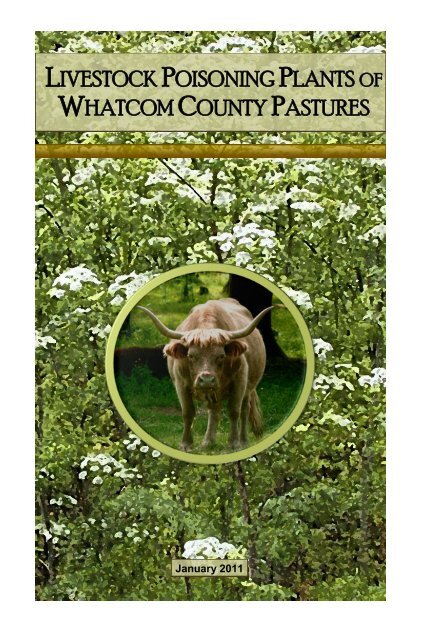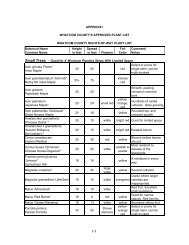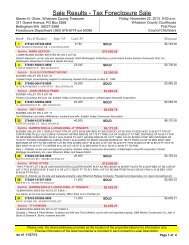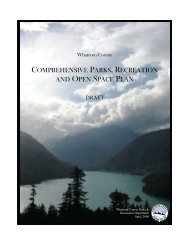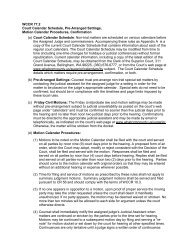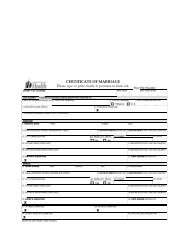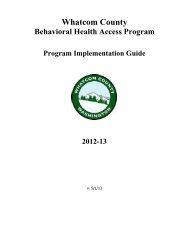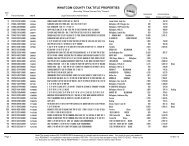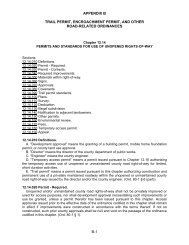Poisonous Plants Booklet - Whatcom County
Poisonous Plants Booklet - Whatcom County
Poisonous Plants Booklet - Whatcom County
Create successful ePaper yourself
Turn your PDF publications into a flip-book with our unique Google optimized e-Paper software.
LIVESTOCK<br />
POISONING<br />
PLANTS<br />
OF<br />
WHATCOM<br />
COUNTY<br />
PASTURES<br />
January 2011
POISONOUS PLANTS INCLUDED IN THIS GUIDE<br />
Introduction ..................................................... 2<br />
Brackenfern ...................................................... 3<br />
Buttercup ......................................................... 4<br />
Cherry .............................................................. 5<br />
Common Groundsel ......................................... 6<br />
Field Horsetail .................................................. 7<br />
Foxglove ......................................................... 8<br />
Lupine ............................................................. 9<br />
Nightshades ..................................................... 10<br />
Poison Hemlock ............................................... 11<br />
Spurge Laurel ................................................... 12<br />
St. John’s-wort ................................................. 13<br />
Tansy Ragwort ................................................. 14<br />
Western Water-hemlock ................................... 15<br />
<strong>Plants</strong> to Avoid Planting near Pastures .............. 16<br />
References ....................................................... 17<br />
Poison hemlock (Conium maculatum)
Introduction<br />
This guide has been designed to help landowners identify some common<br />
plants in <strong>Whatcom</strong> <strong>County</strong> which are potentially poisonous to livestock.<br />
While this booklet is not intended to be a complete guide to poisonous<br />
plants, it does provide some basic information for the land and livestock<br />
owner. <strong>Plants</strong> which are currently listed on the Washington State Noxious<br />
Weed List are indicated on the pages by a green side bar.<br />
The Signs/Symptoms listed on the following pages are those that are most<br />
likely to be observed. Symptoms may vary greatly depending on the quantity<br />
of plants eaten and the time taken to eat the plants. The toxicity of a<br />
plant may also change during the growing season. In addition, different<br />
animals or species may respond differently to the toxins.<br />
For example, sheep may be more susceptible to lupine poisoning than cattle<br />
and horses. Cherry is more toxic after a freeze or wilting. The alkaloids of<br />
tansy ragwort accumulate in the liver and the animal slowly weakens over<br />
time, while the symptoms of poison hemlock appear quickly as the nervous<br />
system is attacked.<br />
Some plants remain toxic after being dried. Animals can become ill by eating<br />
weed-contaminated hay or feed. This type of poisoning is more difficult<br />
to control, and often results in new weeds spreading on your property.<br />
Reasonable handling of your feed areas and careful inspection of imported<br />
hay will help prevent some problems.<br />
In general, pastures which are wisely managed have few undesirable<br />
plants. Animals with good feed and forage available to them will usually<br />
avoid eating toxic plants. Be sure to watch your animals for unusual<br />
changes in behavior. If you suspect a poisoning, consult a veterinarian as<br />
soon as possible.<br />
Everlasting-Pea (Lathyrus latifolius)<br />
2
COMMON<br />
LIVESTOCK<br />
POISONING<br />
PLANTS<br />
OF WHATCOM<br />
COUNTY<br />
PASTURES<br />
BRACKEN FERN<br />
Pteridium aquilinum<br />
Description: Bracken fern, or<br />
western bracken, is a wideranging<br />
native plant that grows in<br />
shaded woodlands, upland pastures,<br />
and recently cleared or<br />
burned land. It is a large fern up<br />
to 4 feet in height. The broad triangle-shaped<br />
leaves grow in<br />
groups of three. Rusty spores are<br />
found on the undersides of the<br />
leaves. It dies back each fall.<br />
Toxicity Rating: Low<br />
Toxic Parts: The spores, leaves, and the roots contain a cumulative poison.<br />
The toxin remains in the plant after drying.<br />
Signs/Symptoms: Bracken fern poisonings<br />
are rare. Horses develop the<br />
signs of bracken fern poisoning over<br />
a 2 to 4 week period. Considerable<br />
quantities of fern must be eaten, either<br />
in the fresh state or as hay. A<br />
disease called "fern staggers" results.<br />
Signs include a staggering gait,<br />
twitching muscles, a weak, fast pulse<br />
and convulsions. Death occurs several<br />
days to weeks after the onset of<br />
symptoms. Cattle, sheep, goats, and pigs can also suffer from bracken poisoning<br />
and can cause blindness.<br />
3
BUTTERCUP<br />
Ranunculus sp<br />
Description: There are two types of<br />
buttercup which are weedy in northwest<br />
Washington. Creeping buttercup<br />
(Ranunculus repens) has bright<br />
yellow flowers with 5 to 10 petals.<br />
The green leaves have dark markings<br />
across the top. It is a creeping, low<br />
growing plant. Tall buttercup,<br />
(Ranunculus acris) grows up to 3 feet<br />
tall. The flowers have five shiny, yellow<br />
petals, which are 1/2 inch long.<br />
The leaves are toothed and deeply<br />
divided. Both buttercups are native to<br />
Europe. They are most often found in<br />
moist pastures and meadows. Buttercups generally bloom from April to<br />
June.<br />
Toxicity Rating: Low<br />
Toxic Part: The juice of the entire plant contains the toxin ranunculin.<br />
Signs/Symptoms: When buttercup<br />
is eaten by livestock, it irritates<br />
the mouth and intestinal<br />
tract. This can result in blisters<br />
and ulcers. All livestock can be<br />
affected. When the plant occurs<br />
in dry hay it is harmless. Unfortunately,<br />
moving contaminated<br />
hay is a common way of spreading plants to other sites.<br />
Animals will avoid buttercup when there is dependable alternative forage,<br />
but this allows the plant to seed and spread freely. Eventually it can overrun<br />
a pasture. Avoid overgrazing.<br />
4
CHERRY<br />
Prunus sp.<br />
Description: A variety of plants in<br />
the rose family, of which cherry is<br />
a member, are known to cause<br />
livestock poisoning. These include<br />
apricots, peaches, plums, sweet<br />
cherries, sour cherries, and chokecherries.<br />
Cherry is a shrub or small<br />
tree with finely toothed, alternately<br />
placed leaves. The creamy-white<br />
flower clusters bloom in the spring<br />
and the red cherry-like fruits are<br />
seen in midsummer.<br />
Toxicity Rating: Low/Moderate<br />
Toxic Part: The seed or pit of the fruit, twigs and leaves are toxic. Wild and<br />
cultivated cherries contain the toxin. Sudden wilting or freezing concentrates<br />
the toxin in the leaves. The leaves of the plant are most toxic early in<br />
the growing season and again in early fall.<br />
Signs/Symptoms: Livestock which eat a large amount of the leaves over a<br />
short time may die without exhibiting symptoms. When smaller amounts<br />
are consumed by livestock their symptoms may include, breathlessness,<br />
convulsions, suffocation, and a bright red bloody discharge from the nose<br />
and mouth. Prompt treatment by a veterinarian can result in almost immediate<br />
recovery.<br />
Although horses rarely eat cherry, cattle, sheep, and even deer relish the<br />
leaves. Keep hungry animals away from areas where cherry is common.<br />
Remove any downed branches which have fallen due to pruning or wind<br />
damage.<br />
5
WASHINGTON STATE NOXIOUS WEED<br />
COMMON GROUNDSEL<br />
Senecio vulgaris<br />
Description: Common groundsel<br />
is a summer or winter annual, possibly<br />
a biennial. It has hollow<br />
stems and grows 6 to 18 inches<br />
tall. It has deeply lobed leaves<br />
and yellow, tubular flowers borne<br />
in clusters at the end of the stalks.<br />
Seeds are produced in a small<br />
dandelion-like puffball. Common<br />
groundsel usually flowers from<br />
spring into the fall, but can flower<br />
year-round during mild winters. It<br />
generally has a small taproot, with<br />
small, secondary, fibrous roots.<br />
Common groundsel grows best<br />
during cool, moist weather.<br />
Toxicity Rating: Moderate<br />
Toxic Part: All parts of the plant, both fresh and dried, are poisonous<br />
to livestock.<br />
Signs/Symptoms: Common groundsel contains<br />
the same alkaloid found in tansy ragwort.<br />
Irreversible liver damage and the<br />
same symptoms observed in tansy ragwort<br />
poisoning occur with common groundsel.<br />
Most poisoning occurs by feeding livestock<br />
contaminated hay. Some animals may not<br />
die from poisoning, but will remain in poor<br />
shape. Cattle and horses are more seriously<br />
affected than goats and sheep.<br />
6
FIELD HORSETAIL<br />
Equisetum sp.<br />
Description: Probably no county in the<br />
state is without some species of horsetail<br />
or scouring rush. This plant is related to<br />
ferns. It spreads quickly with creeping<br />
roots, especially in wetlands. It invades<br />
pastures and croplands from infested<br />
stream banks and ditches. The round<br />
stems of horsetails are grooved and hollow.<br />
The branches are whorled. <strong>Plants</strong> are<br />
typically evident in the spring through<br />
late summer, though some species are<br />
evergreen.<br />
Toxicity Rating: Low<br />
Toxic Part: The entire plant is toxic.<br />
Horsetail contains a toxin, also in bracken fern, which interferes with vitamin<br />
B1 metabolism.<br />
Signs/Symptoms: In horses, watch for loss of coordination, slow pulse,<br />
arched back, trembling, and lying down. Convulsions and coma usually<br />
precede death. Cattle and sheep are<br />
not as susceptible.<br />
Because horsetail is not palatable to<br />
animals, it is generally avoided.<br />
Poisoning typically occurs when<br />
plants are included in hay. Hay that<br />
contains at least 20% horsetail may<br />
produce symptoms in horses in 2-5<br />
weeks. Horsetail is a difficult plant<br />
to control once it is established.<br />
7
FOXGLOVE<br />
Digitalis purpurea<br />
Description: Introduced from Europe, this<br />
biennial plant is found along roadsides, in<br />
fields and forest edges at low elevations. It<br />
is also cultivated as a garden ornamental.<br />
The first year of growth will produce a<br />
low growing mound of leaves. The leaves<br />
are egg-shaped, softly hairy with finely<br />
toothed edges. A long stem with flowers is<br />
produced in the second year. The purple<br />
to white flowers are tubular, growing on<br />
stalks from about 1-5 feet tall.<br />
Toxicity Rating: High<br />
Toxic Part: Flowers, leaves, seeds, both<br />
fresh and dried, contain cardiac glycosides.<br />
Heart medicines, Digitalis and Digoxin, are derived from this plant.<br />
Signs/Symptoms: Rapid breathing,<br />
irregular heartbeat, diarrhea, convulsions.<br />
Poisonings of livestock from<br />
this plant are infrequent as it is fairly<br />
unpalatable. Poisonings can occur<br />
when animals eat contaminated hay.<br />
When poisonings do occur, they are<br />
dramatic and severe and often result<br />
in death. Foxglove is poisonous to<br />
both humans and animals.<br />
8
LUPINE<br />
Lupinus sp.<br />
Description: This hardy perennial in<br />
the Pea (legume) family is often<br />
grown as a garden ornamental. Many<br />
species of lupine occur in Washington<br />
State, most of which are native.<br />
Leaves are palmately divided with 10-<br />
20 leaflets. <strong>Plants</strong> are upright and can<br />
reach heights of up 3 feet or more.<br />
Blue to purple flowers are most common,<br />
but there are pink, white and<br />
yellow flowers also.<br />
Toxicity Rating: Moderate/High<br />
Toxic Part: Leaves, seeds and fruit<br />
contain quinolizidine alkaloids. The<br />
plant is also toxic when dried.<br />
Signs/Symptoms: Excitement, head pressing, difficult breathing, loss of<br />
coordination, salivation, seizures.<br />
Lupine is toxic to all livestock, but<br />
sheep are especially susceptible. Fatalities<br />
may occur when less than 1% of the<br />
animal’s body weight is eaten. Cows<br />
that have eaten lupine within the first<br />
40-70 days of pregnancy may produce<br />
deformed calves. This is known as<br />
“crooked calf syndrome”. Not all species<br />
of lupine are toxic or cause birth<br />
defects.<br />
9
NIGHTSHADES<br />
Solanum sp.<br />
Description: Bittersweet Nightshade<br />
(Solanum dulcamara) is a woody, trailing perennial<br />
vine with small purple and yellow<br />
flowers which are star-shaped. Showy berries<br />
are green to red. Another nightshade<br />
common in our area is Hoe (or Hairy)<br />
Nightshade (Solanum physalifolium). It is a<br />
tap-rooted annual, growing upright (0.5-2.0<br />
ft) and covered in soft hairs. Flowers are<br />
white and yellow. Smooth, round berries<br />
are green to brown.<br />
Toxicity Rating: Low/ Moderate<br />
Toxic Part: All parts are toxic, especially the<br />
leaves and green berries, in both species.<br />
Neither is considered very palatable.<br />
Signs/Symptoms: Loss of coordination,<br />
weakness, diarrhea, excessive salivation,<br />
Photo by WA State Noxious Weed Control Board<br />
slowed heart rate, labored breathing, dilated pupils. There are many members<br />
of the nightshade family, all with varying degrees of toxicity. Deadly<br />
Nightshade (Atropa belladonna) is uncommon here, very poisonous, and is<br />
often confused with Bittersweet Nightshade.<br />
Photos by Tim Miller, Washington State University 10
WASHINGTON STATE NOXIOUS WEED<br />
POISON HEMLOCK<br />
Conium maculatum<br />
Description: Introduced from<br />
Europe as a garden ornamental, poison<br />
hemlock has since become widespread<br />
along pasture borders, roadsides,<br />
waterways, croplands, and<br />
gravel pits. The plant resembles other<br />
plants in the parsley family, like wild<br />
carrot, to which it is related. Unlike<br />
the hairy-leaved wild carrot, the hollow<br />
stems of poison hemlock are<br />
smooth and hairless and have purple<br />
streaks and blotches (shown below).<br />
The umbrella-shaped clusters<br />
of flowers are lacy and white. Flowering<br />
is from May to September.<br />
Toxicity Rating: High<br />
Toxic Part: All parts of the plant, especially the roots, seeds, and early<br />
spring leaves, are poisonous to humans and livestock. The toxin remains<br />
in the plant after drying.<br />
Signs/Symptoms: Some signs of poisoning<br />
include nervous trembling, salivation,<br />
clumsiness, pupil dilation, a rapid, weak<br />
pulse, and difficult breathing. Death can<br />
occur within hours. In cattle, ingestion of<br />
non-fatal amounts of hemlock in the first<br />
trimester of pregnancy can cause birth<br />
defects. Since the fresh leaves have a nauseating<br />
taste and odor, they are usually<br />
avoided by livestock.<br />
11
WASHINGTON STATE NOXIOUS WEED<br />
SPURGE LAUREL<br />
Daphne laureola<br />
Description: This evergreen<br />
shrub grows up to 3-4 feet tall.<br />
Whorls of dark green, shiny,<br />
leathery leaves grow at the ends<br />
of the branches. The small yellow-green<br />
flowers appear in<br />
late winter to early spring, with<br />
oval, black berries produced in<br />
early summer. Birds are the<br />
primary means of dispersal and<br />
spread of this plant. Spurge laurel<br />
is slow-growing and deeply<br />
tap-rooted.<br />
Toxicity Rating: Moderate<br />
Toxic Part: All parts of the plant are poisonous to humans and animals,<br />
especially dogs and cats. The sap can cause severe skin and eye irritation.<br />
Poisoning usually occurs with the berries. The toxin remains in the<br />
plant after drying.<br />
Signs/Symptoms: Burning lesions<br />
in the mouth, diarrhea, vomiting,<br />
stupor, weakness, convulsions.<br />
While livestock poisoning has been<br />
rare, it should be noted that this<br />
plant is spreading quickly in the<br />
Pacific Northwest, so livestock<br />
may encounter it more frequently.<br />
As with many landscape plants,<br />
trimmings from Spurge Laurel should never be left in areas where animals<br />
have access to them.<br />
12
WASHINGTON STATE NOXIOUS WEED<br />
ST. JOHN'S-WORT<br />
Hypericum perforatum<br />
Description: St. John's-wort is a<br />
European species which is now<br />
widely established throughout the<br />
United States. It grows in orchards,<br />
meadows, pastures, along roadsides,<br />
and other sites where the<br />
ground is not tilled every year. The<br />
yellow flowers have 5-7 petals that<br />
appear in early summer. When held<br />
up to the light, the oval leaves appear<br />
to be covered by tiny pin<br />
pricks. Stems are 1 to 3 feet high. In<br />
late fall, the plant turns a rusty<br />
brown and remains standing all<br />
winter. This plant is sometimes<br />
confused with tansy ragwort.<br />
Toxicity Rating: Moderate<br />
Toxic Part: The entire plant, especially<br />
the leaves and flowers contain the toxin,<br />
hypericin. Hay containing dry St. John'swort<br />
can cause poisoning in winter.<br />
13<br />
Signs/Symptoms: Once in the bloodstream,<br />
the toxin causes white-skinned<br />
animals to become sensitive to the sun.<br />
Over time, animals will exhibit symptoms<br />
of blistering, hair loss, difficult<br />
breathing, rapid pulse, foaming at the<br />
mouth, weight loss, and blindness. At the<br />
first signs of poisoning, move affected<br />
animals out of direct sun and provide plenty of feed and water. Both<br />
livestock and humans can be affected.
WASHINGTON STATE NOXIOUS WEED<br />
TANSY RAGWORT<br />
Senecio jacobaea<br />
Description: In the Northwest, tansy<br />
ragwort is a major livestock poisoning<br />
plant that grows in pastures and<br />
along roadsides. It blooms from July<br />
through September. The daisy-like<br />
yellow flowers produce seeds which<br />
are transported by wind, water, and<br />
animals. The leaves are deeply cut,<br />
giving it a ragged appearance. The<br />
plant can reach six feet in height. It<br />
can be distinguished from other<br />
plants by counting the yellow petals<br />
on the flowers—usually 13 per<br />
flower.<br />
Toxicity Rating: Moderate/High<br />
Toxic Part:: The entire plant is toxic. Higher levels of toxin may occur<br />
in the flowers. The toxin remains in the plant after drying.<br />
Signs/Symptoms: Tansy ragwort toxins will build up in livestock and<br />
lead to liver damage. Poisoned animals may become easily agitated,<br />
have loss of appetite, chew on fences and<br />
dirt, become weak, and have a staggering<br />
gait. Some animals may not die, but will<br />
remain in poor shape. This condition is not<br />
reversible. Cattle and horses are more seriously<br />
affected than goats and sheep. Poisoning<br />
often occurs by feeding livestock contaminated<br />
hay. This is also a common way<br />
of spreading the weed. Animals can also be<br />
affected by this plant in the spring when<br />
young plants are mixed with the desirable<br />
grass forage.<br />
14
WESTERN WATER-HEMLOCK<br />
Cicuta douglasii<br />
Description: Native to the Pacific<br />
Northwest, this highly poisonous plant<br />
is found in wet pastures, meadows, and<br />
along streams. The plant grows from 2<br />
to 8 feet tall. It has small, white flowers<br />
that grow in clusters like tiny umbrellas.<br />
A distinctive feature is the chambered<br />
root (shown below in cross-section). The<br />
plant begins growth in early spring. It<br />
flowers from spring to early summer.<br />
Toxicity Rating: High<br />
Toxic Part: All parts of the plant are extremely poisonous to humans and<br />
animals. A piece of root the size of a walnut is enough to kill a mature cow.<br />
Signs/Symptoms: Poisoned animals display muscle twitching, a rapid<br />
pulse, frothing at the mouth, violent convulsions, coma and death. The onset<br />
of symptoms is rapid and death can occur in as little as one hour.<br />
Animals will seldom eat water-hemlock when good forage is available.<br />
Unfortunately, the plant may appear early in the spring before grass is<br />
available. Severe losses may occur when<br />
roots become exposed and are eaten by<br />
animals. It is best to keep animals away<br />
from known infestations until the plants<br />
are removed. Be very cautious when<br />
handling this plant and wash hands and<br />
tools afterward as it is also very poisonous<br />
to humans.<br />
15
Landscape <strong>Plants</strong> to Avoid Planting<br />
Near Pastures<br />
This list is not all-inclusive, but highlights some commonly used landscape plants<br />
for this area.<br />
Trees/Shrubs/Vines<br />
Boxwood, Oak species, Red Maple, English Laurel, English Ivy*,<br />
Ponderosa Pine, Black or Honey Locust, Mountain Laurel, Serviceberry,<br />
Rhododendrons, Azaleas, Mountain Ash, Spurge Laurel*, Domestic<br />
plum, cherry or peach, Golden Chain Tree (Laburnum), Nandina,<br />
English Holly, Black Walnut, Clematis, Hawthorn (Crataegus),<br />
Pyracantha, Cotoneaster, Snowberry, Japanese Pieris, Yew, Elderberry,<br />
Swamp Laurel (Kalmia sp.), Horse Chestnut, Wisteria, Daphne,<br />
Hydrangea, Virginia Creeper, Trumpet Creeper.<br />
Herbaceous <strong>Plants</strong><br />
Lily-of-the-Valley, Narcissus/Daffodils, Autumn Crocus, Bleeding<br />
Heart, Rhubarb, Castor Bean, Larkspur, Perennial (Everlasting) Pea,<br />
Foxglove, Monkshood, Yellow Flag Iris*, Lupine, Mole Plant, Nightshades,<br />
Chrysanthemum, Common Tansy*, Oriental Poppy, Star-of-<br />
Bethlehem, Snowdrops, Donkeytail Spurge*.<br />
*indicates plants currently listed on the Washington State Noxious Weed List<br />
Bleeding Heart (Dicentra spectabilis)<br />
16
• Blackwell, Will H. <strong>Poisonous</strong> and Medicinal <strong>Plants</strong>. Prentice Hall, 1990.<br />
• Fuller, Thomas C. and Elizabeth McClintock. <strong>Poisonous</strong> <strong>Plants</strong> of California.<br />
University of California Press, 1986.<br />
• Kingsbury, John M. <strong>Poisonous</strong> <strong>Plants</strong> of the United States and Canada.<br />
Prentice Hall, 1964.<br />
• Pojar, Jim and Andy MacKinnon. <strong>Plants</strong> of the Pacific Northwest Coast.<br />
Lone Pine Publishing, 1994.<br />
• Lincoln Co. Noxious Weed Board. <strong>Plants</strong> <strong>Poisonous</strong> to Horses and<br />
Livestock,<br />
Web Sites:<br />
Canadian <strong>Poisonous</strong> <strong>Plants</strong> Information System:<br />
www.cbif.gc.ca/pls/pp/poisonp_x=px<br />
Colorado State University Guide to <strong>Poisonous</strong> <strong>Plants</strong>:<br />
www.vth.colostate.edu/poisonous_plants/report/search.cfm<br />
Cornell University <strong>Poisonous</strong> <strong>Plants</strong> Home Page:<br />
www.ansci.cornell.edu/plants/index.html<br />
Equines and Toxic <strong>Plants</strong>:<br />
www.cnr.uidaho.edu/range/toxicplants_horses/Toxic%20Plant%<br />
20Database.html<br />
Ontario: Weeds <strong>Poisonous</strong> to Grazing Livestock:<br />
www.omafra.gov.on.ca/english/livestock/dairy/facts/poisonousweeds.htm<br />
University of Pennsylvania <strong>Poisonous</strong> <strong>Plants</strong> Home Page:<br />
cal.vet.upenn.edu/projects/poison/index.html<br />
University of Vermont Extension:<br />
www.uvm.edu/pss/vtcrops/articles/VT<strong>Poisonous</strong><strong>Plants</strong>.pdf<br />
17
IF YOU THINK YOUR ANIMALS ARE<br />
EXHIBITING SYMPTOMS OF POISONING…<br />
Contact a veterinarian immediately<br />
Collect full samples—including flowers,<br />
leaves and roots—of the suspect plants.<br />
If you suspect that you have poisonous plants on your<br />
property and need more information, please contact the<br />
Noxious Weed Program for a site inspection and/or to get<br />
the plants identified:<br />
360-715<br />
715-74707470<br />
Production Credits<br />
Contributors: Laurel Baldwin, Monette Boswell, Don Burgess<br />
All photos not credited are property of <strong>Whatcom</strong> <strong>County</strong> Noxious Weed<br />
Board, and may be reproduced with permission.<br />
Third printing, originally published 1995.<br />
Printed on 100% post-consumer, chlorine-free paper with soy-based ink by<br />
Premier Graphics, Bellingham Washington<br />
January 2011<br />
Yellow Flag Iris (Iris pseudacorus)
<strong>Whatcom</strong> <strong>County</strong> Noxious Weed Board<br />
322 N. Commercial Street, Suite 110<br />
Bellingham WA 98225<br />
Phone 360-715-7470<br />
www.whatcomcounty.us/publicworks/weeds/index.jsp


